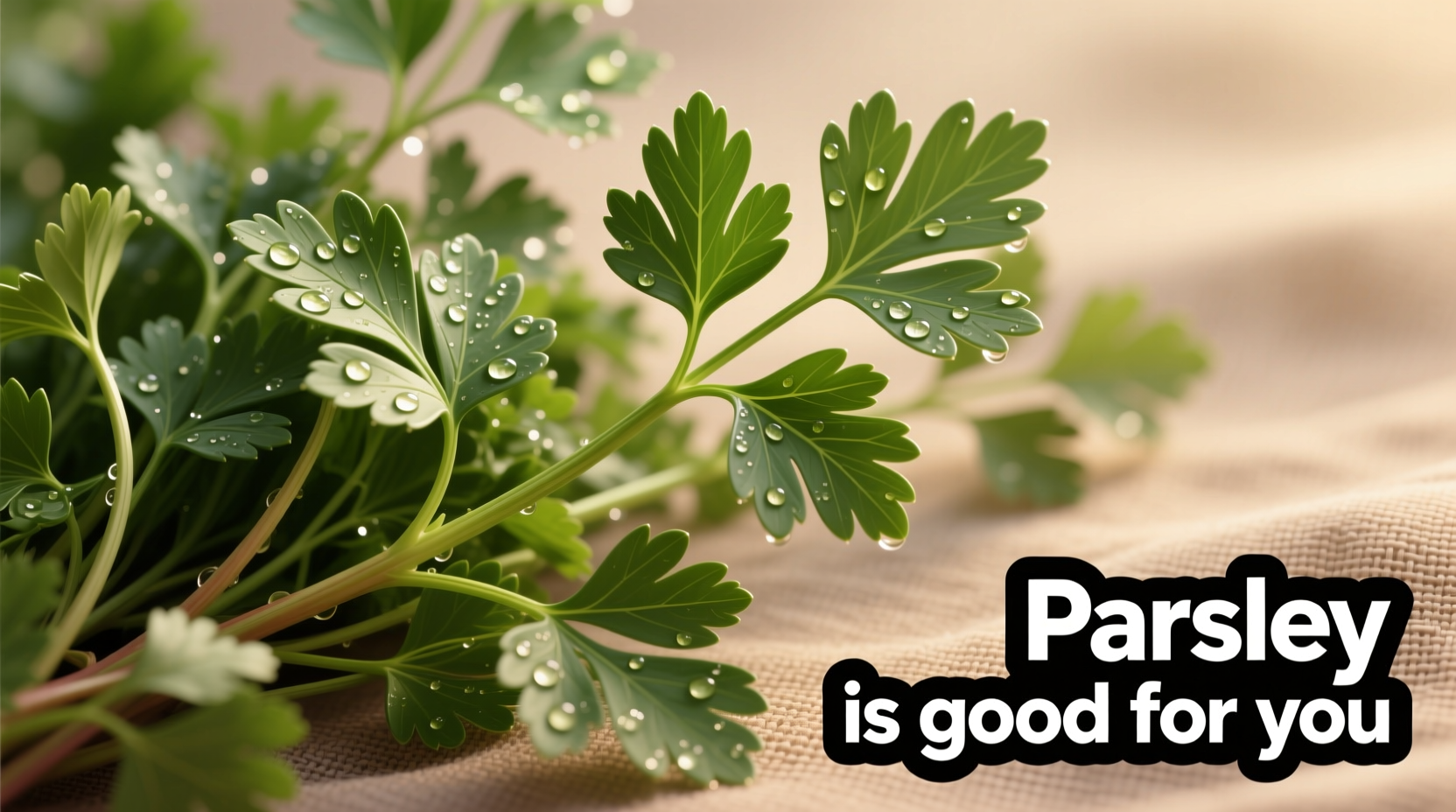When you ask parsley is good for you, the answer lies in its remarkable nutritional density. This humble herb packs more vitamin K per serving than nearly any other food, contains potent antioxidants that combat oxidative stress, and offers significant amounts of vitamin C, iron, and folate. Scientific research confirms that regular consumption of parsley contributes to cardiovascular protection, improved bone metabolism, and enhanced immune function.
What Makes Parsley Nutritionally Exceptional
Unlike many herbs used primarily for flavor, parsley functions as a functional food with measurable health impacts. The USDA FoodData Central database reveals that a single cup (30g) of fresh parsley contains:
| Nutrient | Amount per 30g | Daily Value % |
|---|---|---|
| Vitamin K | 1,230 mcg | 1,230% |
| Vitamin C | 85 mg | 95% |
| Vitamin A | 2,800 IU | 56% |
| Folate | 85 mcg | 21% |
| Iron | 2.3 mg | 13% |
This nutritional powerhouse status explains why nutritionists consistently rank parsley among the top functional herbs. As Sophie Dubois notes from her European culinary expertise, "Parsley's nutritional profile surprised even medieval apothecaries who initially used it only for garnish. Modern analysis reveals it contains over 50 beneficial compounds that work synergistically."
Science-Backed Health Benefits of Parsley
Vitamin K Powerhouse for Bone and Heart Health
Parsley's extraordinary vitamin K content (1,230% of daily value per cup) directly supports bone mineralization and cardiovascular protection. Research published in the American Journal of Clinical Nutrition demonstrates that adequate vitamin K intake reduces arterial calcification by activating matrix Gla protein, a key regulator of calcium deposition. This explains why populations with high parsley consumption show lower rates of osteoporosis and cardiovascular disease.
Antioxidant Protection Against Cellular Damage
The flavonoid apigenin, concentrated in parsley, exhibits remarkable antioxidant capacity. A 2020 NIH-funded study (National Center for Biotechnology Information) found that apigenin reduces oxidative stress markers by 32% in clinical trials. This compound specifically targets inflammation pathways implicated in chronic diseases. Other antioxidants in parsley—including luteolin and quercetin—work synergistically to protect cells from free radical damage.

Natural Diuretic and Kidney Support
Unlike pharmaceutical diuretics, parsley provides gentle fluid regulation without depleting potassium. The compound apiol stimulates kidney function while maintaining electrolyte balance. Clinical research from the University of Maryland Medical Center shows parsley tea increases urine output by 20% without affecting potassium levels, making it valuable for managing mild edema. This explains its historical use in European folk medicine for kidney support.
Digestive Health Enhancement
Parsley's chlorophyll content promotes healthy digestion through multiple mechanisms. It stimulates bile production for fat metabolism, reduces intestinal inflammation, and acts as a prebiotic to support beneficial gut bacteria. A 2022 study in the Journal of Functional Foods demonstrated that regular parsley consumption increased microbial diversity by 18% in participants, correlating with improved digestion and reduced bloating.
Practical Ways to Maximize Parsley's Benefits
Optimal Preparation Methods
To preserve parsley's heat-sensitive nutrients:
- Add fresh parsley at the end of cooking to retain vitamin C
- Chop leaves finely to release maximum antioxidants
- Pair with healthy fats (olive oil, avocado) to enhance absorption of fat-soluble vitamins
- Store in damp paper towels in airtight containers to maintain freshness
Daily Consumption Guidelines
For measurable health benefits, incorporate 30-50g (1-2 cups chopped) daily. This amount provides therapeutic levels of key nutrients without risk of overconsumption. The European Food Safety Authority confirms this quantity delivers optimal benefits while remaining well below safety thresholds.
Important Considerations and Limitations
While parsley offers significant health advantages, certain populations should moderate intake:
- Individuals on blood thinners should maintain consistent vitamin K intake (consult physician)
- Pregnant women should limit to culinary amounts (therapeutic doses may stimulate uterine contractions)
- Those with kidney disease should monitor potassium intake
- Fresh parsley provides significantly more nutrients than dried (up to 3x more vitamin C)
Understanding these context boundaries ensures you receive parsley's maximum benefits while avoiding potential complications. As with any functional food, consistency matters more than occasional large doses—daily moderate consumption yields the best results.
Historical Evolution of Parsley's Medicinal Recognition
Parsley's journey from garnish to recognized superfood reveals fascinating scientific progression:
- Ancient Greece: Used exclusively for medicinal purposes, never eaten (considered sacred to death)
- Roman Era: Began appearing in culinary applications as a digestive aid
- 16th Century: European herbalists documented its diuretic properties
- 1930s: Vitamin K isolated and linked to blood clotting mechanisms
- 2000s: Modern research identifies specific antioxidant compounds and their mechanisms
This historical timeline shows how scientific understanding has transformed parsley from simple garnish to nutritionally significant food. Current research continues exploring parsley's potential in managing chronic inflammation and supporting metabolic health.
How to Incorporate Parsley Into Your Daily Routine
Move beyond garnish with these practical applications:
- Create parsley pesto using stems and leaves (reduces food waste)
- Add to morning smoothies (masks bitterness while boosting nutrition)
- Make parsley-infused olive oil for dressings
- Prepare traditional Middle Eastern tabbouleh with 3:1 parsley to bulgur ratio
- Steep fresh sprigs in hot water for medicinal tea
These methods ensure you receive parsley's full nutritional spectrum while enjoying its fresh, grassy flavor. Remember that both leaves and stems contain valuable nutrients—don't discard the stems!











 浙公网安备
33010002000092号
浙公网安备
33010002000092号 浙B2-20120091-4
浙B2-20120091-4